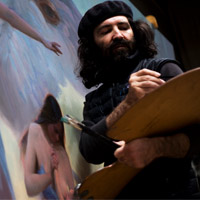Realist Revolution and Critical Relevance by Alexey Steele
The most Memorable Panel Discussion at PSOA
After enormously intense and exciting Spring of our fantastic PSOA adventure in DC and the “Hottest Summer” on record with three concurrent shows and quite a bit of painting it’s great to come back and to reflect on most fascinating intellectual exchange and sharing of ideas we had at the Realist Revolution panel. Good times are timeless and not soon-forgotten! Here are my thoughts, notes and comments on it in three parts.
Part I
These were my thoughts going into that most memorable panel:
We live in a corrupt world that in so many ways has lost its way, regardless of good intentions it might’ve had at the beginning of its most recent dead end. It happened many times before: oppressed rebels taking reins of absolute power, indulge in it, becoming corrupt oppressors themselves and running the whole thing in their hands to a ground. Human nature is ever the same. Yet, this is exactly at those junctions when the new turns happen. We are the lucky generation at such a turn.
This is the only reason we are all at the point we find ourselves today. There are many words to describe what we all experience, yet the most crucial thing that makes it all possible I think and gives meaning to any words is the very simple and exciting fact – we have a critical mass of highly developed talent hitting their prime while united under very similar views and practices. Just look at events like PSOA, Masters, our Classical Underground, rooms where these greatest talents share their views in panel discussions or show what they can do in demos and lectures are packed with truly youthful vibrancy and excitement. In any classic definition – it is a movement!
There is definitely much to reflect upon for everyone and that is what I think about it.
One important thing to understand – we are not a “preseravationist society” or certainly not any more, we are contemporary artists and an inseparable part of the overall multi-dimensional and diverse “Greater Art World”. There is in a sense no more of what used to be called “Art World” as very narrowly defined and much in-bread closed circuit. We are a community and we are part of a greater community.
Insuring the knowledge transfer is the great duty of anyone I think who takes his or her participation within an unbroken chain of tradition seriously. It is in a way our sacred duty and those who did it before us in a darkest hour with greatest of commitment and sacrifice have a permanent place in history. We and everyone after us – are and will be forever grateful to them.
Yet, the noble tradition that we for whatever combination of determination and fortune have managed to acquire is just a tool at our disposal – we have to use it accepting all responsibility for a remarkable time in history we are so fortunate to be part of.
It is the extent to which we will manage to apply this noble tradition which we represent that will secure its place in the Future – the Future that we can all be part of shaping now and the place that will be much different from what it was throughout last century, particularly its second half.
Art that we love is a Force, we have to master it through understanding of Great Tradition and not to simply ensure that knowledge transfer, but to use this Force to answer the deeply personal calls of our times… times of our own and of our viewers.
Through the knowledge transfer we are given the power of our artistic ancestors. Through us their Force lives on in our time, speaking to hearts of our people.
Soldiers use the “Lethal Force to Kill” on a battlefield – We, the artists, are in a possession of a “Vital Force to Heal”… to recreate Life itself.
We have to be conscious of this power to wield it. And wield it we shall. One brush stroke at a time. The Spirits of Great Ones before us are smiling upon us today. We are the first genuine movement of the 21st century.
We better be worthy of the honor… and damn the torpedoes!!!
***
Part II
On Friday April 23rd, 2010 my comrade-in-brush, a truly great artist Jeremy Lipking and myself put together a panel discussion at the PSOA conference in Washington DC titled
Contemporary Art:
Realist Revolution
And
Critical Relevance
Is mainstream media missing an important cultural trend?
Firmly moderated by Jeremy, the panel’s distinguished members were:
Jacob Collins
One of the most accomplished realist painters of our time, founder of influential and in my view the closest to the ideals of Academic educational tradition Grand Central Academy in New York
Vern G. Swanson, Ph.D
Director of Springville Museum of Art in Sprinville, Utah, an authority on the Academic Art of the 19th century with major books on Alma Tadema and John William Godward among many others as well as on Russian Realist School of the Soviet Period. I had a privilege contributing to his authoritative “Soviet Impressionism” book that recently went through its second edition.
James Panero
Writer and Managing Editor of intellectually formidable The New Criterion, one of the sharpest pens and minds around, who is still willing and able to thrust both with fencing precision.
So here is the program of the panel starting with that great Alfred Barr quote Jeremy dug out:
An actual “battle of styles,” as for instance between realism and abstraction, is desirable only to those who thrive on a feeling of partisanship. Both directions are valid and useful—and freedom to produce them and enjoy them should be protected as an essential liberty. There are, however, serious reasons for taking sides when one kind of art or another is dogmatically asserted to be the only funicular up Parnassus or, worse, when it is maliciously attacked by the ignorant, the frightened, the priggish, the opportunistic, the bigoted, the backward, the vulgar or the venal. Then those who love art or spiritual freedom cannot remain neutral.
—Alfred Barr, 1949 first director of MOMA
Premisis
Along with its own topic the panel is intending to continue on some fascinating themes and topics raised by a recent important panel “Future of Art Criticism” held at MOCA on Thursday, March 25, 2010 and organized by Annenberg School of Communication at USC;
Our aim is to encourage the much needed dialog within the greater Art community.
The extensive report on the panel could be found at www.novorealism.com
Questions to panel participants:
Q. Should same journalistic standards be applied to art criticism?
Q. How appropriate is the use of a term “contemporary” to describe just an “officially” sanctioned by establishment singular part of cultural process?
Q. What aspects of newly emerging Realist movement are the most fascinating to you?
Q. What are the limitations to the currently ultimate power of critic to ignore and how do you see the future of Art Criticism?
Q. Do you believe that institutions claiming to be representative of contemporary process in Art shall be reflecting existing aesthetic diversity on the ground?
Q. At the MOCA panel Bennett Simpson stated: “It is not Art Criticism’s Job to move Art Forward, it’s Art’s Job to move Art Forward. It used to be in the past – not any more.” For all that it means coming from such representative of the establishment, what kind of Art do you think will move the Art forward?
And here the fun began…
gotta tell you, outside of a few particular moments in life including some most memorable painting sessions, this was the most exhilarating experience.
***
Part III
In addition to the program and videos I am also posting the notes to my own answers as well. Sorry, they are as raw as toro ever gets
Q. Should same journalistic standards be applied to art criticism?
I believe as moderator on that MOCA panel put it that “ anybody writing anything commits an act of journalism,” essentially I believe that anybody associating with institutional voice has a responsibility and shall adhere to principles of impartial observation of reality.
I do not believe that “journalism” is just a form of a “classified” or a “calendar of events” – it is silly to reduce journalism to recitation of “what, who and where”, so the personal choice, call and opinion are inherent to journalism. Yet journalism does stand for a credibility of an impartial description of reality particularly as a voice of institutional authority to a wider public.
Much of establishment criticism was for a long time and still remains anything but “intelligent impartial observer” it implies to be, it largely became an integral part of an essentially a special interest group.
As it is now most of official art criticism in media lost any of its credibility as an intelligent, competent, unattached observer. As it stands now, art criticism is primarily involved in a business of propaganda and advertisement, pushing very expensive goods for special vested interest. Blowing air into a Koons/Hirst bubble is a very sad example.
Koons and Hirst are a sub-prime of the Art world – an un-substantiated by any underlying value artificial asset, hyper-inflated through blatant push on the levers of power.
Q. How appropriate is the use of a term “contemporary” to describe just an “officially” sanctioned by establishment singular part of cultural process?
“Contemporary” as defined in Wiki dictionary is “someone or something from the same period” any other limitations on its use shall be considered an act of naked privatization by special vested interest of an ultimately public and shared asset – our common language.
It is an action of the same kind as putting penalties on using rain water in one of Latin American countries by a multinational corp. or privatization of industrial giants built by slave labor of Gulag prisoners in the Soviet Union by the descendants of those who sent those prisoners there in the first place.
This very simple and logical realization shall have massive implications as either the content or the name of every collection claiming being “contemporary” would have to be dramatically altered to maintain any legitimacy.
Q. What aspects of newly emerging Realist movement are the most fascinating to you?
Realism has perhaps 30 to 35 000 year old history, it is enormously diverse and it obviously went through many periods of drastic transformations. Yet our stage in realism’s development is I think enormously exciting and unique, particularly because of modernist and deconstructionist experience of the last century.
It is the first time in at least few centuries that the widening appreciation of Realism happens not as a matter of habit but as a matter of a clear choice. Personally I am grateful to modernism for that. It is a deeply “re-constructionist” movement today. Positive, forward looking and bringing hope to the world in crisis. It starts from afresh and it is enormously exciting.
I believe that American Realism is the most current form of American Non-Conformism
Q. What are the limitations to the currently ultimate power of critic to ignore and how do you see the future of Art Criticism?
Power to ignore is a formidable beast, yet it only works when you have the total control on the information flow either through exclusive grip on media channels or exclusive grip on credibility. Modern criticism has lost both. Blogs took away the medium while Koons/Hirst -credibility.
In this precarious situation ignoring real and exciting trends on the ground dooms any “official arbiter” to irrelevance. They are simply missing the train, as the train of ART does not wait for anyone.
I do believe in the Future of Art criticism much as I believe in the Future of ART itself. We do need critics’ perspective unbiased by anything except of their knowledge, competence, and brilliance. Criticism shall have various voices reflecting the richness in true ART diversity of our time and as same event in ART could be viewed from multiple viewpoints. They just have to be represented equally and no single point of view shall be in a position of an “officially sanctioned” opinions. This outlived mode simply cannot sustain any longer, as it is not reflecting a true scope of contemporary reality.
Art criticism of the future I believe is in a unique combination of artist’s passion and journalistic integrity coming through brilliant writing. This criticism will always have a future as long as there is the last Artist and the last Viewer in the world. Critic is an ultimate and passionate viewer who just knows what he or she is looking at.
Q. Do you believe that institutions claiming to be representative of contemporary process in Art shall be reflecting existing aesthetic diversity on the ground?
Absolutely, without it they don’t have a moral or intellectual right to exist. The entire content of every contemporary art collection shall be dramatically reexamined to reflect the actual diversity on the ground. It is an enormously exciting process of rethinking of the basics. Yet how else the true modern Art can ever expect functioning?
This realization came to me after I conducted what I came to call a “Utah Experiment.” In a process of judging an annual show at the Springville Museum of Art instead of following the usual safe way of picking middle-of-the-road works, at my suggestion the jury went on to picking the most extreme examples in the entire range of works submitted. The result was unexpectedly fabulous. The best of realist paintings looked surprisingly good next to best abstract, conceptual and extreme alternative works, everything looked fresh and strong next to each other, the routine of same old was broken.
I believe that this historically inevitable rethinking will actually give a new life and purpose to the institutions in deep crisis, extending their lease on life – more new projects, new comparative exhibitions, new catalogs, new conversations, new debate and primarily and mainly – a new connection to contemporary audiences.
Q. At the MOCA panel Bennett Simpson stated and it’s a quote: “It is not Art Criticism’s Job to move Art Forward, it’s Art’s Job to move Art Forward. It used to be in the past – not any more.” For all that it means coming from such representative of the establishment, what kind of Art do you think will move the Art forward?
I believe in a Great Art, in a pinnacle of achievement whichever form it will take, in every individual case. Just averagely good won’t be enough. If history of ART is a case study and it certainly is to me, the whole spectrum of extraordinary – from Vermeer’s direction of a profoundly close look at the ordinary and intimate to Michelangelo’s epically all-encompassing look at heroically human… There are no limitations to greatness.
Yet from my perspective, and again, if we take history as a case study, I believe in a rise of real multi-figure composition as an inevitable next step of deeper fascination with a figure. Composition and big symphonic visual form is what is missing in our ART life. Composition gives visual purpose, as we shall not fall pray to infinite “etudism” as we called it in Russia. The purpose of etude or study is just that – study for a complete work and a process of making yourself better as an artist to accomplish it. At some point you got to use all that.
in ART we trust!






